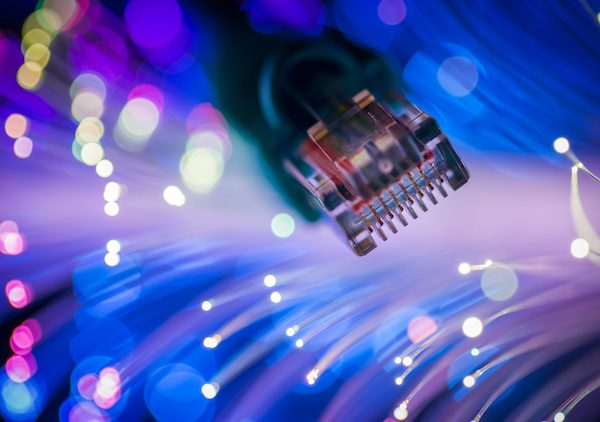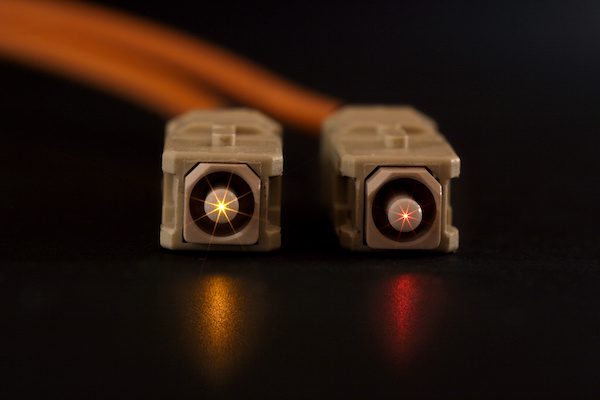Choosing the Right Connectors for High-Speed Factory Automation Networks
As automation becomes increasingly prevalent in modern manufacturing, the demand for high-speed factory automation networks is on the rise — and specifying the right connectors for these harsh environments is crucial.

Source: Adobe Stock ID 538643362.
As automation becomes increasingly prevalent in modern manufacturing, the demand for high-speed factory automation networks is on the rise. The networks responsible for connecting myriad devices such as sensors, actuators, controllers, and robotics enable seamless communication and control. Wireless networks, including Wi-Fi and cellular, are also gaining popularity for multi-Gb/s and high-speed networking. Choosing the right connectors for these networks is critical to ensuring optimal performance, reliability, and scalability.
Network speeds today are a far cry from the 1.492 Kb/s of early RS-232 serial communications, or even the 10 Mb/s of RS-485, which is used by the popular Profibus and Modbus protocols. Today, the ubiquitous Ethernet protocol is the choice for most networks. It is mostly deployed at 100 Mb/s bandwidth but increasing demand for real-time, low latency communications, and the growth of machine vision, are pushing Ethernet networks to 10 Gb/s or higher.
Factory automation applications
As a starting point, here are some of the most common factory automation applications, the most popular types of connectors for cabled networks (wired and fiber optic), and the parameters that matter when making connector choices.
- Assembly lines: In assembly line applications, high-speed communication between robotic systems and controllers is crucial for maintaining efficiency and reducing production time.
- Materials handling: Automated materials handling systems, such as conveyors, automated guided vehicles (AGVs), and automated storage and retrieval systems (AS/RS), require mechanically robust connectors to withstand harsh environments, including vibrations, dust, and moisture.
- Machine vision: Machine vision systems, which include cameras, sensors, and image processing equipment, need to support high-speed, high-bandwidth data transfer and provide reliable, interference-free connections.
- Process control: In process control applications, connectors may be exposed to high temperatures, aggressive chemicals, and high electrical noise levels while maintaining reliable communication between sensors, actuators, and controllers.
Factors to consider when choosing a connector for a high-speed factory automation network
- Bandwidth and data rate: The connector must support the required bandwidth and data rate for the application. In most instances, these are defined by the network standards for which the connectors are designed. For example, an RJ45 Ethernet connector is often used in industrial networks at bandwidths of up to 10 Gb/s, equivalent to a data rate of 1.25 GB/s. Network specifications also set out the distances over which the protocols are designed to operate.

Ethernet networks operate over both wired and fiber optic cabling in industrial plants. (Source: AdobeStock_74362101)
- Electrical specifications: These include the number of conductors, voltage and current ratings, and contact resistance. Lower contact resistance ensures better signal integrity for data connections and minimizes losses in power connections. Contact and contact plating materials can have a significant impact on performance, and on the environmental tolerance of connectors. Where high-density, high-speed interconnect is involved, for example on backplanes, insertion loss and crosstalk performance may also be important connector selection criteria.
- Environmental resistance: The connector should be able to withstand the environmental conditions of the application. Specifications include the temperature range over which the connector will maintain reliable performance, tolerance to humidity, and exposure to chemicals or contaminants. Connectors with an IP rating (Ingress Protection) specify the level of protection the connector provides against dust, water, and other contaminants. IP69K is the highest IP standard, defined as “protection against close-range, high pressure, high temperature spray downs.” Connector housing materials also need to be considered for harsh operating environments.
- EMC/EMI: Electromagnetic compatibility (EMC) and electromagnetic interference (EMI) are often important considerations in industrial applications, not least because of the potential for interference from switch mode power supplies, motors, microprocessor clocks, and even LED lighting. Every conductor is an antenna of sorts, including printed circuit board tracks. Particularly for high-speed circuits, the shielding and grounding arrangements within connectors need to be considered, and where available, versions with integrated EMC suppression components may help reduce system design complexity and printed circuit board size.
- Mechanical robustness: The connector should be able to withstand the physical demands of the application, such as vibration, shock, and mechanical stress. This is particularly important in materials handling and process control applications, where connectors are subjected to harsh environments and heavy use. The number of mating cycles that the connector can withstand, the insertion and withdrawal force, and the cable retention force are particularly important in applications where connectors may be inserted and withdrawn frequently.
- Termination type: Wire connectors are available with various termination types including solder, crimp, and insulation displacement connectors (IDC). The choice of termination type depends on factors such as ease of installation, reliability, and maintenance requirements. Where optical fibers are used for the network infrastructure, these may be spliced together or joined with connectors.
- Size and form factor: The connector should be compact enough to fit within the available space and should be easy to install and maintain. In some applications, low-profile connectors or connectors with a right-angle design may be necessary to fit within tight spaces.
- Standards compliance: The connector’s compliance with relevant industry standards, such as ISO, IEC, or ANSI, ensures compatibility and performance within factory automation networks.
- Safety and regulatory certifications: The connector’s adherence to safety and environmental regulations, such as RoHS, UL, or CE, can be crucial for certain applications.
The most common connectors in factory automation networks
RJ45: RJ45 connectors are the most widely used connectors in Ethernet-based communication networks, the protocol that dominates factory automation systems. These 8-pin connectors, usually used to connect twisted pairs of wires, connect devices like programmable logic controllers (PLCs), human-machine interfaces (HMIs), and industrial computers. To eliminate the need for separate DC power feeds, POE (power over Ethernet) RJ45 connectors have become popular options in many applications. In factory automation, Ethernet is mostly used at speeds from 100 Mb/s to 10 Gb/s, but this is increasing. RJ45 connectors come in myriad formats, including versions with integrated components to mitigate EMI.

M12X and RJ45 connectors are popular for wired Ethernet connections in factories but the circular connector is more rugged and comes in a wide range of IP ratings. (License: Creative Commons – Attributon, Anordal via Wikipedia.)
M12: M12 connectors are circular components with a 12 mm locking thread, designed specifically for harsh industrial environments. They come in 3, 4, 5, 8, and 12 pole versions. M12 connectors are resistant to dust, water, and vibration and carry power, data, and signals. Their coding designations — how the pins and housing are formatted — are indicative of the most suitable applications for each version, although these are not rigidly defined. For example: A-coded for DC power, 1 Gbit Ethernet, and sensors; B-coded for PROFIBUS; C-coded for AC power; D-coded for 100 Mbit Ethernet; K-coded for high power (7 kW) AC; L-coded for DC power; X-coded for 10 Gbit Ethernet, and Y-coded for connecting DC power and data up to 100 Mb/s over a single cable. C-coded and A-coded parts are gradually being superseded by S-coded and T-coded versions.
M8: Also known as “nano M8 connectors,” these are smaller than M12 types and have an 8 mm locking thread. These are ideal for applications with space constraints or where a lightweight connection is required. M8 connectors are often used in sensor and actuator connections within factory networks.
Industrial USB: These are more robust than standard USB types, with features such as IP67-rated sealing, enhanced EMI/RFI shielding, and resistance to harsh environments. They are frequently used in data acquisition, machine vision, and automation control applications.
Fiber optic
Fiber optic connectors are used to connect optical fibers in high-speed networks, offering high data transfer rates and immunity to EMI. Some common fiber optic connector types include FC, LC, MPT/MPO (multi-fiber), SC, and ST connectors. Of these, the LC (Lucent Connector) is currently the most used. Fiber optic connections are ideal for applications requiring long-distance communication or when EMI is a significant concern, and some are capable of transmitting data at over 1 petabit per second.

Fiber optic cabling and connectors offer high speed and high immunity to electrical interference in factories but are more expensive than conventional copper wire networks and connectors. (Source: AdobeStock_2675575)
Backplane connectors
Backplane connectors provide a high-speed communication link between electronic modules or subsystems. Each family is available in a wide range of configurations. They’re used on the edges of printed circuit boards to plug them into rack-based assemblies, and for interconnecting between various parts of systems, sometimes connector-to-connector and at other times via wire harnesses. The most popular types for factory automation include DIN 41612 (based on the DIN standard), VME, CompactPCI, PC/104, and PMC, but there are many others.
Selecting the right connector type for a high-speed factory automation network is crucial for ensuring reliable communication and data transfer between devices and components. Each connector type has its own set of features and advantages, catering to different requirements in terms of environmental resistance, data transfer rates, and ease of installation. Only by understanding the applications and specifications, can engineers and system integrators make informed decisions when designing and implementing cost-effective and reliable high-performance networks.
To learn more about solutions for automated industrial applications, visit Avnet.
Like this article? Check out our other Harsh Environment and Automation articles, our Special Topics Page, and our 2023 and Article Archives.
Subscribe to our weekly e-newsletters, follow us on LinkedIn, Twitter, and Facebook, and check out our eBook archives for more applicable, expert-informed connectivity content.





